LANGUAGE JOURNEYS
What is Language Journeys?

Language Journeys is an educational platform for independent learning so that you can become your best teacher. It is a new way to learn languages based on progressive learning and the idea that you can learn a language while traveling.
On your journey you will be placed in situations that you might encounter if you decided to start a journey in real life.
What is the difference between a traditional course and a journey?
You usually take courses in formal education to pass exams and get an official certificate. On a journey the focus is on language learning itself, not learning in order to get a certificate. This resembles more the way in which natural learning takes place.
Upon finishing the journey you will be able to pass exams – just like you are able to pass an exam in your mother tongue – but it will be a consequence, not the goal of the journey.
What languages are available?
We currently offer English, Spanish, French and German, and expect to add new content regularly. We hope to add more languages depending on users’ response.
What method is used?
Progressive Learning
Language Journeys combines a story-based approach with progressive learning and different types of exercises to help you notice and acquire the target language effectively. Learning while traveling will give you a reason to continue, making the process more entertaining and meaningful.
In other words, you don’t get to the next unit to learn all “colors”, “family members” or “weather conditions”, but you learn them progressively, just like in real life.
Your journey consists of several activities organized by levels according to the Common European Framework of Reference for Languages.
Each activity starts with a narration, which provides the context for the dialogue or exercise that follows. At beginner level the narration appears in your first language (L1), and simply by clicking on it, you can see the translation in your target language (L2).
The translations get reversed eventually, so that you can follow the story in the target language and see the translation in your first language.

Implicit and Explicit Input
The activities take into account both implicit and explicit learning, whose combination is the ideal way to learn a new language. The storyline has been developed with “comprehensible input”, so that you can infer the meaning of new words based on the context. However, there are situations where you will need explicit instruction. This is why in those cases you will see some grammar tips to clarify the corresponding topic.
In other words, you will usually read the storyline in the target language and try to guess the meaning of unknown words through the context. If you can’t, then you can click on the translation for explicit instruction. This balanced approach makes our system ideal to keep up your motivation in your language journey.
Interactive Exercises
The storyline gets reinforced by a series of interactive exercises which help you notice language patterns to make the language stick. Those exercises sometimes consist of explicit grammar content and other times they follow a task-based approach. During a task, you will use the language to solve a determined problem or simply to have a meaningful conversation with other characters.
Sometimes you will hear conversations on the part of other characters in the story, and sometimes you will be involved in the story yourself! This means that you will actually be able to ask and answer questions made by other characters along the way. This involvement in the story provides a more emotional type of learning. You will even be able to engage in language battles with “enemies.”
How is the app structured?
The app consists of several levels which contain chapters and activities that get unblocked progressively as you complete them. This structure prevents you from getting confused among too many options and gives clarity and coherence to your learning experience.
You can access any level you want. All levels – except A1 – start with a placement test so that you can decide whether you’re on the right level. The flag icon on top lets you choose the language you want to learn.
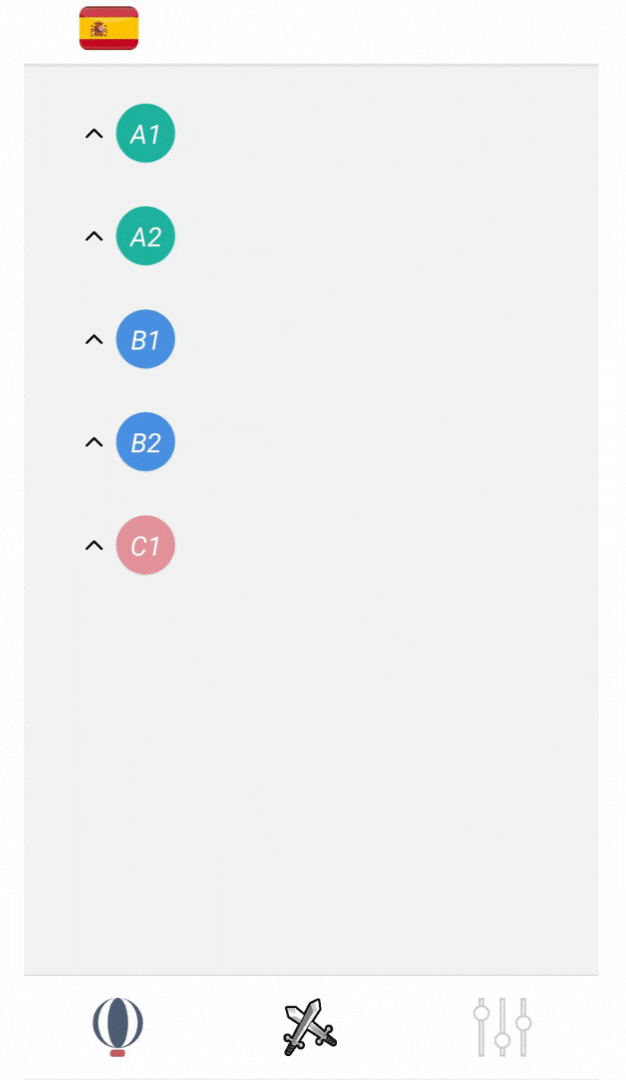
Each activity consists of a story combined with different types of exercises. The exercises integrate seamlessly with the storyline so that you do not learn “random content”, but rather within a meaningful context.
As soon as an exercise starts, you will see an “accuracy icon” on the top right. This icon measures how well you’re doing during the activity by showing the number of correct answers divided by the total number of answers. Clicking on it allows you to see an explanation of your score.
EXERCISES
WRITING
Writing exercises will allow you to build a correct sentence by rearranging the mixed parts, which improves your verbal reasoning skills. You will be able to form sentences both from and into your first language. This type of bidirectional translation will help you notice grammar patterns in both languages so that you can eventually internalize the new language.
LISTENING
Listening exercises follow the same structure as writing exercises except that you will hear the target sentence beforehand without seeing the translation. Then you will have to figure out the correct sentence either in your first or your study language.
Listening will allow you to recognize speech sounds, understand the meaning of individual words, and detect patterns in the syntax of the sentence.
Both writing and listening exercises will either deal with a particular grammar point or they will help you engage in meaningful conversations. This helps strike a balance between explicit and implicit grammar, otherwise called focus on form (FonF) and focus on meaning (FonM).
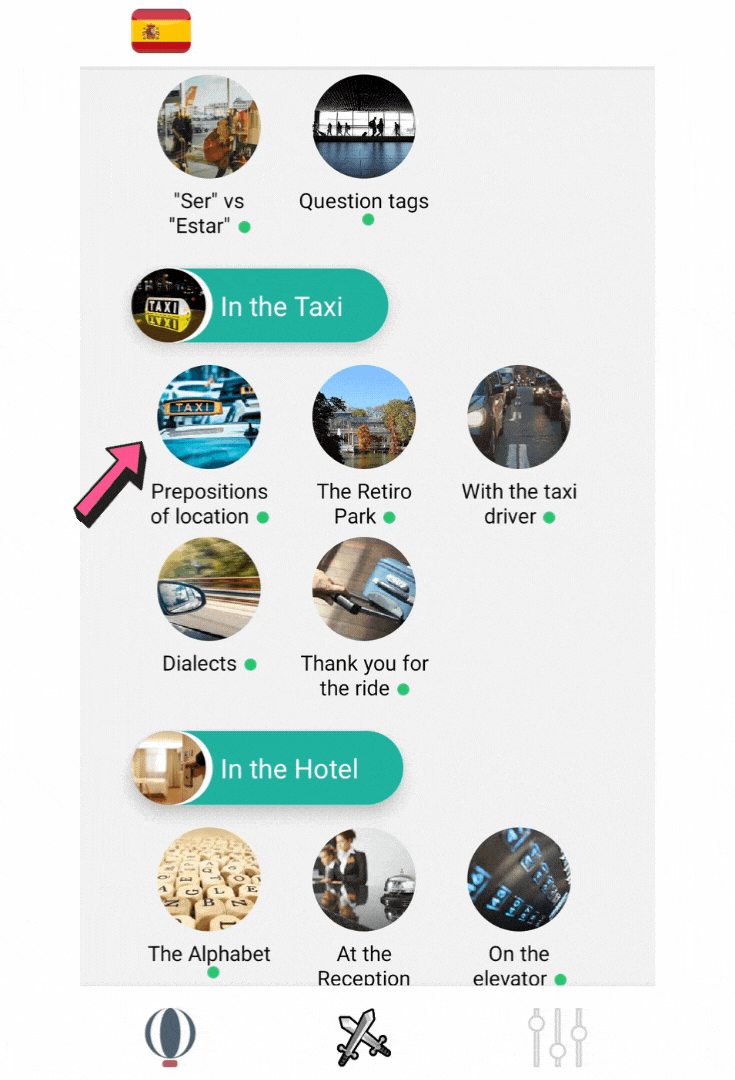
TRANSFORMATION
At beginner level you will notice a certain focus on transformation exercises to provide for a smooth transition from your first language to your study language. The reason for this is that as an adult you are not learning a language, but RElearning it. When you learn a new language your mother tongue reacts, creating interferences.
Transformation exercises help break this barrier and take you from known to new structures so that you can retrain your brain to the new system in a smooth way. While performing the exercises you will notice how the new grammar sticks in your brain as you use old words in new structures or old structures with new words.
Unlike mere repetition, these exercises call for creativity on the user’s part and help you stimulate your linguistic observation and reflection.
During the story you will not only be exposed to expressions with a literal meaning, but also to metaphorical expressions such as idioms, jokes and riddles so that you can increase your associative fluency.
MULTIPLE CHOICE
Multiple choice exercises improve your analytical abilities and encourage you to read in more detail. In some cases a user may know the answer to a question but they are unable to recall it. Seeing the answer triggers the memory to enable a correct answer to be given.
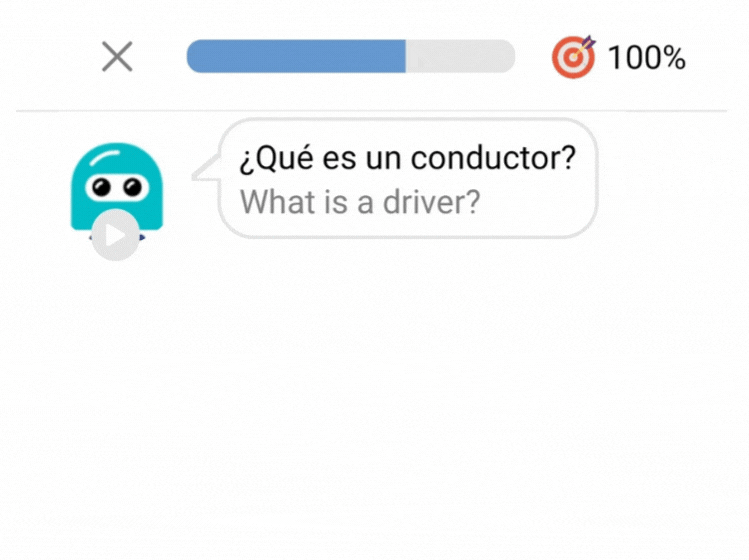
This type of exercise will be accompanied by audio or not, depending on whether the answer forms part of a character dialogue or simply aims at noticing a particular grammar aspect of the language. You will be able to see the translations of any of the choices by clicking on them. In the case of a “challenge”, you will have to click on the correct answer first to see the translations.
Multiple choice exercises can take many forms. They may…
- deal with grammar or vocabulary topics.
- consist of “complete the sentences” exercises.
- feature verbal reasoning exercises such as: finding synonyms, arranging words in a meaningful sequence, completing analogies or learning idioms.
MATCHING
Matching exercises improve your analytical abilities by exercising your language, concentration and memory skills. They are strategically placed along the course so that you review vocabulary items in a spaced repetition way.
This type of exercise can take several forms, both translating from the mother tongue to the target language and matching directly in the target language. Here are some examples.
MATCHING EXERCISE TYPES | |||||||||
PAIRS | RELATED | SYNONYMS | PHRASES | IDIOMS | |||||
blue | azul | doctor | hospital | apart | separate | I'm | home. | ups | and downs |
SPEAKING
Speaking exercises will help you improve your speaking ability. This type of exercise will appear whenever you need to ask or answer a question, or as a summary exercise at the end of an activity. There are two types of speaking exercises, which you can select in the “Settings” section.
With Speech Recognition
This is the default setting. In this mode you have to click on the mic button and pronounce the target sentence out loud. After processing it, the system will show your accuracy by marking the wrong answers in red. You can then choose to continue or repeat the exercise to improve your score.

Without Speech Recognition
This mode is intended for those situations where you prefer to self-assess, either by pronouncing the answer out loud or quietly. To do this exercise you will see part of the target sentence and will have to guess the full sentence. Then you can click on “CHECK” and listen to the correct sentence for self-assessment. Clicking on “I guessed it right” will allow you to move forward. Clicking on “I guessed it wrong” will repeat the exercise.
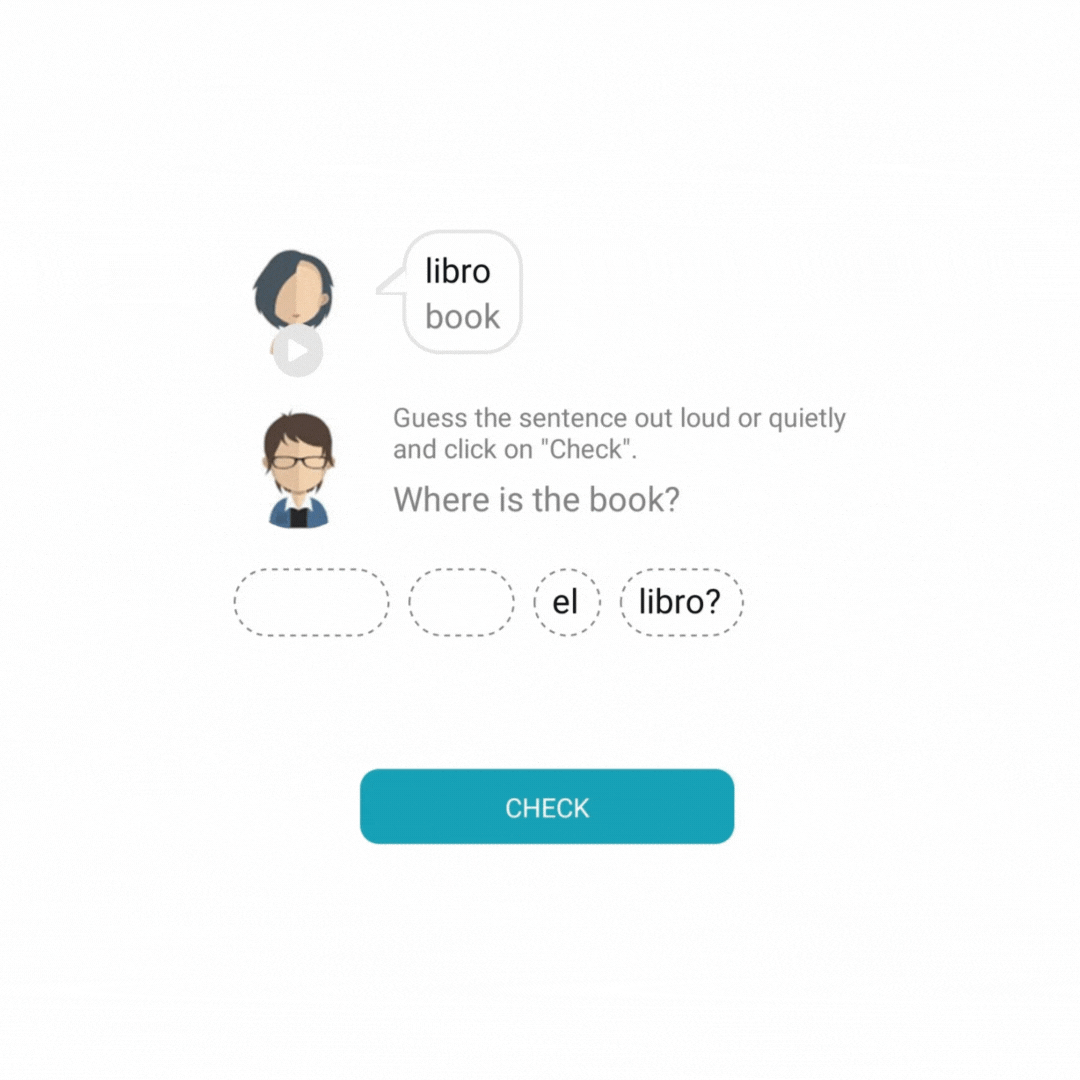
You can choose the amount of clues you need in the “Settings” section. The default setting is 50%. This means that if the target sentence is composed of 6 words, you will see 3 words and the rest will be hidden.
The more clues, the easier the exercise, and the less clues, the more challenging it will be. In any case, you can click on the empty boxes to see the missing clues if necessary.
This innovative learning technique provides a level of customization and progressive learning unprecedented in any other app, web or book of its type.
STORYLINE

Your journey starts at home, where you are with a couple of friends and decide to start a journey to a new country to learn the language.
Your friends take you to the airport and you are eventually placed in situations where you would find yourself if you started a journey in real life. These situations include discovering the new city, meeting new people or finding a place to live.


Along your journey you will meet Aris and Sona. These two AI assistants will help you perform both communicative and grammar-based dialogues.
CHALLENGES
On your journey you will meet certain characters who will test your language abilities. Those characters will be like “enemies” that you will have to defeat. They have been inspired by video game “bosses”, which are characters that must be defeated at the end of certain parts in the game.
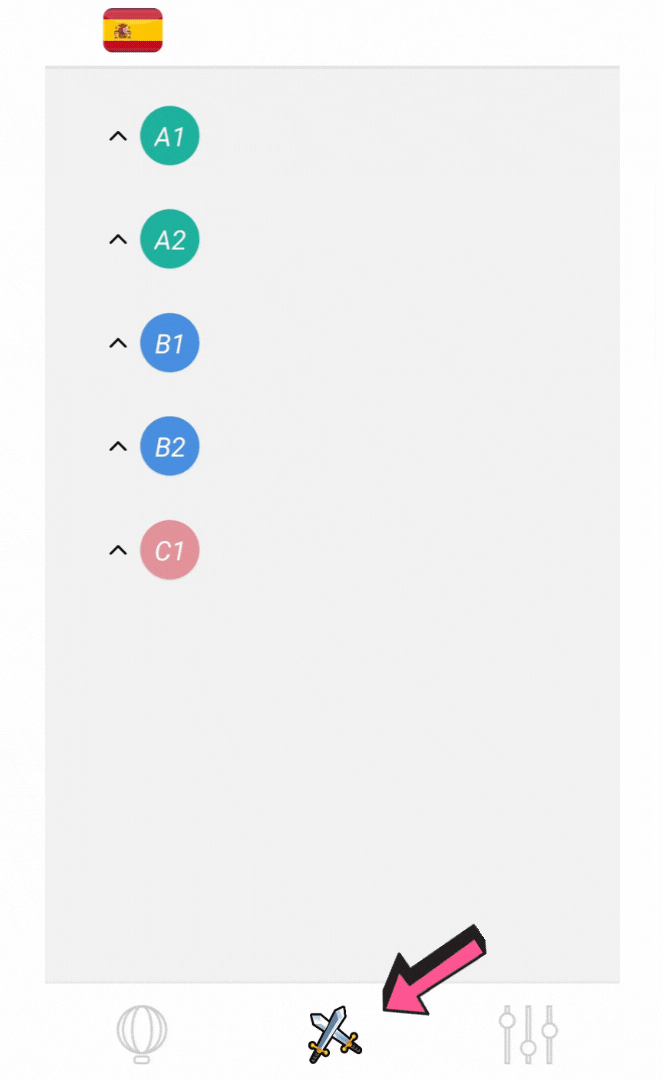
You have a list of all enemies in the challenge section. They will appear during the journey and will turn from gray to colored status once you defeat them.
Each enemy has an “accuracy” level, which is the minimum accuracy that you must retain in order to defeat them. That level appears inside a ticking bomb icon to the left of your actual accuracy in the top menu. If your accuracy drops below the minimum level, then you are defeated and have to restart the activity.
During a challenge, the translations in multiple choice exercises will appear only after you click on the right answer.
SETTINGS
Book View. When disabled, you are taken to the index after finishing every activity. This is the standard setting for most language learning apps. When enabled, you go from one activity to the next directly. This viewing mode recreates the reading of a gamebook.

Accuracy Icon. When enabled you are able to see your progress during every activity. You can disable it in case you don’t want to feel the pressure of being assessed.

Speaking Exercises. When disabled, all speaking exercises will turn to writing mode. This option is intended for those cases where you can’t or don’t feel like speaking.

Listening Exercises. Just like with speaking exercises, when disabled, all listening exercises will turn to writing mode.

Speech Recognition. When enabled, your sentence is analyzed by speech recognition. When disabled, you pronounce the sentence and self-assess yourself.

Speak Mode Clues. These are the visible hints to help you pronounce the sentence in a speaking exercise. The more hints, the easier the exercise will be. It is set at 50% by default.
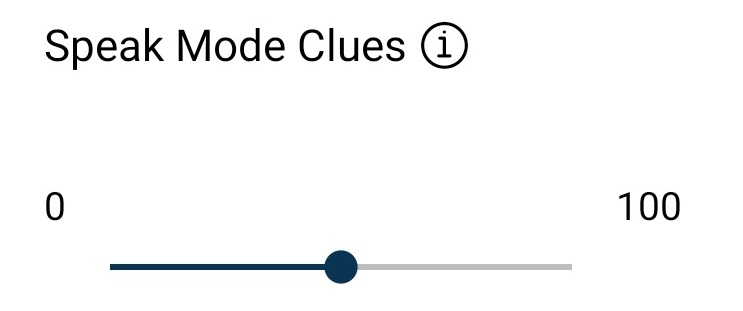
Extra Words. This is the amount of extra words that appear in a writing exercise. The more extra words, the more challenging the exercise will be. It is set at 20% by default. For example, if a sentence consists of 5 words, the system will show one extra word for challenge purposes, since 5 words x 20% = 1 extra word.
